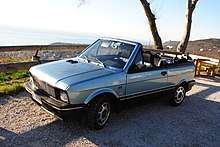Yugo
The Yugo (pronounced [ˈjûɡo]), also marketed as the Zastava Koral (pronounced [ˈzâːstaʋa ˈkǒraːl], Serbian Cyrillic: Застава Корал) and Yugo Koral, is a subcompact car hatchback formerly manufactured by Zastava Automobiles, at the time a Yugoslav corporation.
| Yugo | |
|---|---|
.jpg) 1987 Yugo GV Sport | |
| Overview | |
| Manufacturer | Zastava |
| Also called | Yugo Innocenti Koral Koral Yugo Koral |
| Production | 28 November 1980 – 11 November 2008 |
| Assembly | Kragujevac, Yugoslavia |
| Body and chassis | |
| Class | Subcompact (B) |
| Body style |
|
| Layout | FF layout |
| Related | |
| Powertrain | |
| Engine | 0.9 L OHV I4 1.0 L OHV I4 1.1 L SOHC I4 1.3 L SOHC I4 |
| Transmission | |
| Dimensions | |
| Wheelbase | 2,150 mm (84.6 in) |
| Length | 3,485 mm (137.2 in) |
| Width | 1,548 mm (60.9 in) |
| Height | 1,390 mm (54.7 in) |
| Curb weight | 825 kg (1,819 lb) to 920 kg (2,028 lb) |
Originally designed in Italy, as a shortened variant of the Fiat 128, the first Yugo prototype was manufactured on 2 July 1977. Series production started on 28 November 1980. The Zastava Koral, a facelifted model, was marketed until 11 November 2008, after production of 794,428 cars.[1]
The Yugo was marketed in the United States from 1985 to 1992 by Malcolm Bricklin, with a total of 141,651 sold – peaking at 48,812 in 1987 and falling to 1,412 in 1992.
The car has been subjected to much criticism over its design and reliability; the historian Jason Vuic has called it "the worst car in history."[2]
Models
Over the course of its production, the model range was marketed under various nameplates:
- Yugo 45 / Zastava Yugo 45 (Yugoslavia, United Kingdom, Europe)
- Yugo 55 with the bigger engine from Zastava 101, also carbureted (Yugoslavia, U.K., Europe)
- Yugo 60 [1.1L engine Weber twin barrel carburetor version] (Germany, Europe, Latin America)
- Yugo 60efi (1.1L Electronic fuel injection engine) (Germany, Europe, Latin America)
- Yugo 65 [1.3L engine Weber twin barrel carburetor version] (Germany, U.K., Europe, Latin America)
- Yugo 65efi (1.3L Electronic fuel injection engine) (Germany, Europe, Latin America)
- Yugo GV (United States)
- Yugo GV Plus Automatic (U.S.)
- Yugo GV Sport (U.S.)
- Yugo GVC (U.S.)
- Yugo GVL (U.S.)
- Yugo GVS (U.S.)
- Yugo GVX (1.3L EFI engine) (U.S.)
- Yugo Cabrio (U.S., Germany, Yugoslavia, Greece)
- Zastava Koral (Serbia, Europe)
- Zastava Koral 1.0E (903 cc Economic engine) [33 kW/45 hp] (Serbia, Europe)
- Zastava Koral In 1.1i [46 kW/63 hp] (Serbia, Europe)
- Zastava Koral In 1.3i [50 kW/68 hp] (Serbia, Europe)
- Zastava Koral In L [44.1 kW/60 hp] (Serbia, Europe)
- Zastava Koral 45/55 Van (Serbia, Europe)
- Yugo Cabrio (Yugoslavia, Europe)
- Yugo Ciao (Yugoslavia, Europe)
- Yugo Tempo (Yugoslavia, Europe)
- Yugo Tempo — circa 1991
- Innocenti Koral (Italy)
- Innocenti Koral Cabrio (Italy)
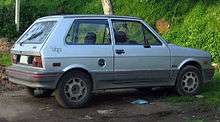
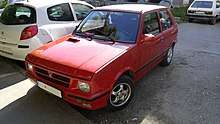
.jpg)
Earlier models
Yugo 45 derivative models have included the Yugo 55, 60, 65, Koral, Ciao, Tempo, Cabrio, GV, GV Plus, GVX, and GVL. Yugo engines were fitted with a carburetor until well into the 1980s before fuel-injected models (starting with the Koral 65) were gradually introduced, beginning with the GVX-EFI (an electronic fuel injection system), which featured a 1300-cc engine. Yugo did not only target the West: In early 1985 500 Yugos were exported to China, and exports to Bulgaria and Egypt were already established.[3]
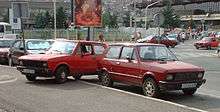
The fuel-injection system was a Motronic MP3.1, which was later developed with Bosch to Motronic M4.6 MPI on 1.1- and 1.3-L engines and had multiport fuel injection with a three-way catalytic converter and "Lambda" sensor.[4]
Later models
Near the end of its production run, Zastava sold an updated version of the Yugo Koral model, known as the Zastava Koral IN, which had central locking, a three-step rotary switch on the dash marked "0", "1", "2", and "3" for a headlamps leveling control in four height positions, a four-speaker audio system, electric windows, folding electro-adjustable side-view mirrors, alloy wheels, an optional air conditioner, and an optional Renault-designed three-speed automatic transmission. Zastava sold these in Serbia, Montenegro, Croatia, North Macedonia, Greece, Lebanon, Libya, Syria, Tunisia, and Egypt.
Besides all the Koral versions available, other models included the Florida and Skala. In October 2003, an agreement with Fiat was reached for production of the Fiat Punto by Zastava for Eastern European markets, which was known as the Zastava 10.
The Koral IN L, with a Peugeot fuel-injected 1.1 L-60 PS (44 kW) engine, met the European Union safety standards in a test supervised by the German Technischer Überwachungsverein (Technical Monitoring Association), a necessary step for importation to E.U. countries.
Powertrains
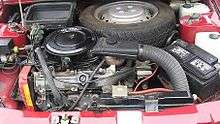
| Engine | Standard | Optional |
|---|---|---|
| 0.9L | four-speed manual | |
| 1.1L | five-speed manual | |
| 1.1L (US) | four-speed manual | |
| 1.3L | five-speed manual | three-speed automatic |
| 1.3L (US) | five-speed manual | three-speed automatic |
Parts production by Yugoslav republics
- Most of the electrical parts were produced in Nova Gorica, Slovenia.
- The interior fittings were made in the Croatian city of Split.
- Brakes were produced in Varaždin, also Croatia.
- The engine's electrical parts were produced in Banja Luka, Bosnia and Herzegovina.
- The Macedonian city of Ohrid was the production site for seat belts, locks, and mirrors.
- The rest of car's parts and final assembly was done in Serbia.[5]
History
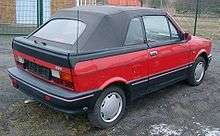
Zastava was founded as an arms manufacturer in 1853. By the late 1930s, the company had expanded into automobile production supplying Ford-designed trucks to the Royal Yugoslav Army. Vehicle production continued until 1941, when World War II reached Yugoslavia. Following the war, Zastava was permitted to produce Jeeps under license from Willys-Overland until production was halted in the early 1950s.
The first passenger models were produced on 26 August 1953 using designs licensed by Fiat of Turin. The first model designed by Zastava was a sedan called the Milletrecento ("one thousand three hundred") powered by a 1,300 cc engine. Some of the most successful models were those based on the Fiat 128 model, marketed under different names: Zastava 101, Zastava 128, Zastava 311, Zastava Skala, etc.
Zastava continued to produce vehicles for the Yugoslav and European markets until exports were limited by sanctions imposed by the United Nations in the 1990s. In 1984, automobile entrepreneur Malcolm Bricklin tested the United States market for Zastava vehicles, now branded as Yugo. As a result, in mid-1986, Yugo America began selling cars at a starting price of $3,990 for the entry-level GV ("Good Value") hatchback equipped with the 1,100 cc overhead-cam five-main-bearing engine and four-speed manual transmission. The similar GVL offered a plusher interior, but the sporty top-line GVX was powered by the 1,300 cc engine mated to a five-speed manual transmission, and included as standard equipment a number of deluxe features such as a ground-effects package, alloy wheels, and rally lights. However, though the GVX was billed as an upscale, sporty version of the base GV, it went from 0-60 mph in 13.56 seconds, just a half a second faster than the GV.[6] When the political instability in Yugoslavia intensified in early 1992, Zastava was forced to stop exports.
Today, various models are available in the former Yugoslavia, including an agreement signed with Fiat for the production of the 2003 Fiat Punto model.[7]
1988–1991
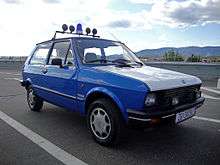
Many mechanics and even Zastava factory workers agree that the "best" Yugos ever were built between 1988 and early 1991. Quality control was good; high standards were set in terms of plastic quality, seat cloth, and "a well screwed together" interior. Paint and antirust coatings were also well done during that period, evidenced by many cars still showing no signs of rust, tears in the seats, or major engine issues after more than 20 years.
1989 was considered a "golden year" for Yugos because almost 200,000 were built that year, and many can still be seen on the road today. Also, cars were usually branded Yugo instead of Zastava during that period, because the company was taking pride in the (at the time) good sales and reputation established in the export markets, especially in the United States.
In 1990, a batch of 450 cars with automatic transmissions and air conditioning was shipped to the United States. With political problems starting in 1991, quality dropped significantly, coming to such low standards such as plastic parts of the dashboard not fitting correctly.
1991–1996
Because the Yugo was built as a "Yugoslav" car with political problems and civil war breaking out in 1990–91, production slowed down and the supply of parts was interrupted. Most of the plastic came from Croatia, while the alternators and electrical equipment came from Slovenia. With the start of civil war, economic and transportation ties were broken, resulting in shortage of most parts coming from the two seceded republics. Though the sanctions were not in place until May 1992, Yugos built between June 1991 and early 1996 were built with a variety of "leftover" parts: as an example, getting a car with a blue dashboard and a brown steering wheel, seats that were mismatched in color, and most likely an "American" instrument cluster with speeds printed in MPH rather than km/h, and with written labels like water and oil instead of small drawings, and a seatbelt safety warning light were possible. In some extreme cases, the car would come with different interior panels and a steering wheel from other Zastava products such as the Zastava 750. When exports to United States (and the rest of the world) stopped, a number of federalized Yugos were still left in the factory's parking lots, and many people got these "American" Yugos instead of the European ones. When Yugoslavia broke apart in the early 1990s, production rates steeply declined to 14,000 in 1992, 7,000 in 1993 and 1994, and 9,000 in 1995. In 1996, when sanctions were lifted, production rates slowly increased as living standards in the former Yugoslavia started to improve. Even so, problems for the factory started once again when it was put out of production in mid-1999 as a result of war with NATO.
In the United States
International Automobile Importers (IAI) was a company founded by Malcolm Bricklin to import the X1/9 and 2000 Spider after Fiat halted their manufacture.[8] Bertone and Pininfarina carried on production under their own names and Bricklin's IAI took over their U.S. importation. Bricklin wanted to import additional brands, and international dealmaker Armand Hammer had been asked by the Yugoslavs to identify business areas in which they could generate exports to bolster their economy. Hammer thought the idea of exporting the small cars made in Kragujevac, Serbia, by Zavodi Crvena Zastava, would be viable. Zastava had, since the mid-19th century, been a quality armaments producer and sponsored its own museum.
As Zastava celebrated its 100th anniversary, it started producing vehicles made under license from the Italian company Fiat, located just across the Adriatic Sea. For three decades, Zastava produced the rear-engined 600 and the 101, a bustle-backed version of the Fiat 128. On its own initiative in 1980, Zastava introduced its Jugo or Yugo model which, though still using Fiat 128-type powertrain and other components, was in fact an update of the Fiat 127 styled in Turin. Zastava was already exporting its new offering to other Eastern European markets, installing the bigger 128 overhead-cam engine for a top speed of 90 mph (145 km/h).

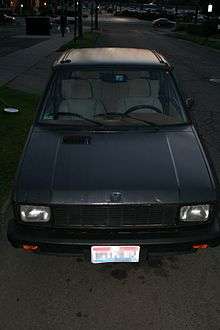
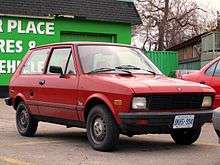
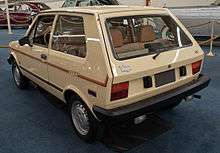
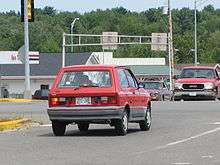
In 1982, U.S. entrepreneur Miro Kefurt contacted Zastava in Kragujevac (ZCZ-Zavodi Crvena Zastava) with an idea to export the Yugo 45 to the United States.[9] The vehicles were to be renamed Yugo GV for the United States market and YugoCars, Inc. was formed in Sun Valley, California, by Kefurt and Ray Burns. The proposal required approval by Fiat in Italy due to existing contractual restrictions in effect for Fiat—Zastava collaborations.
The first three Yugo vehicles, painted red, white, and blue, were introduced to the U.S. public at the Los Angeles Auto Show in May 1984. The car was promoted with a 10-year/100,000-mile warranty, free maintenance, and a price of only $4,500. Front-page articles about the Yugo appeared in the Los Angeles Times (Business Section), New York Times, and The National Enquirer. However, problems soon arose as one car was sent to the California Air Resources Board for emissions testing, which it badly failed. The Yugo needed lots of reengineering, and with no help forthcoming from Zastava, Kefurt was in a problematic situation.[10]
Reportedly, Malcolm Bricklin attended the Los Angeles Auto Show, and while the show was still in progress, flew to Yugoslavia to make a deal to import the Yugo to the United States himself. But Kefurt and YugoCars already held the exclusive import contract for 5,000 vehicles for the 1985 model year to be sold only in California, and the California emissions certification was already in progress. In November 1984, the marketing rights were sold by YugoCars to International Automobile Importers (IAI) for $50,000 ($10 per car). Additionally, Miro Kefurt obtained an exclusive dealer franchise from IAI to sell the Bertone X1/9 in North Hollywood, California.
YugoCars had intended to fit their Yugo 45 with the 903-cc, 45-horsepower 4-cylinder engine with a 3-way catalytic converter and oxygen sensor for emissions control. Predicted gas mileage was 42 to 45 mpg at 70 mph. In late 1983, Zastava added a version called the Yugo 55, powered by a bigger engine used in the Fiat 101/128. IAI's Tony Ciminera preferred using this larger, 1,100 cc engine making 55 horsepower, though it would drop fuel economy to the 30 MPG range, for it was faster and more able to keep up on American freeways. Even so, with an 86 mph (138 km/h) top speed, it was the slowest car sold in the United States.[11]
Setting up Yugo America to import the car, Bricklin assigned Bill Prior to sort out the distribution and Tony Ciminera to fine-tune the Yugo for the American market. Ciminera carried out a bumper-to-bumper audit that resulted in more than 500 changes to meet the needs of the U.S. market, including compliance with American safety and emissions regulations. The vast Yugo facility was patterned after the Fiat factories of the early 1950s and employed 50,000, divided among 85 basic associated labor organizations and 25 work committees. For U.S. models, a separate assembly line was built with handpicked elite staff earning extra pay ($1.23 per hour extra), building Yugos destined for the New World. The first shift began at 6:00 am, and after an eight-hour day, many employees left for their second jobs in other workplaces.
The chief engineer and head of Zastava's Research and Development Institute was Zdravko Menjak, who worked with Bricklin's people at the plant to monitor the effort, constantly stressing the need for high quality. A team of British quality experts went to Kragujevac to study the factory and recommend improvements.
Five models of Yugo were sold in the United States for the 1987 model year: the basic entry-level $3,990 GV (for "Great Value"), the GVC with a glass sunroof, the nearly identical GVL and GVS with minor trim and upholstery upgrades, and the GVX with the 1,300-cc engine, five-speed manual transmission, and standard equipment including a plush interior, ground-effects package, alloy wheels, and rally lights. The Cabrio convertible was introduced in 1988.
In the late 1980s, an automatic transmission was being sourced from Renault and a larger model (named the "Florida") had been styled by Giorgetto Giugiaro and was in the early manufacturing stages. With the end of communism, however, Yugoslavia began to unravel.
By 1990, the GV, GVL, and the 1,100-cc engine and four-speed manual transmission were replaced by a 1,300-cc OHC engine and five-speed manual transmission or a Renault-designed three-speed automatic transmission, and an air conditioner with a holder for cooling two soft drink cans became optional on the GVX model. The standard model became the GV Plus.
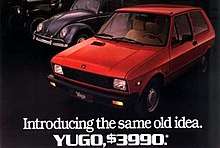
In 1990, Yugo America introduced an fuel-injected version of the Yugo GVX to replace the primitive carbureted engine,[12] but it arrived too late as the result of a recall by the United States Environmental Protection Agency of over 126,000 vehicles sold in the United States because they violated emissions regulations. The recall effectively caused Yugo America to cease importation and fold in April 1992.[13] The noncompliant emission system used a carburetor of outdated design, an old-fashioned two-way catalytic converter with an air pump, and exhaust gas recirculation. The power-reducing application of this primitive emissions control equipment on an already-weak engine was one of the major problems that caused the vehicles to get a reputation for poor drivability.
By the early 1990s, the effects of the United Nations sanctions on Yugoslavia forced Zastava to withdraw the car from every export market. After embargoes stifled production, the coup de grâce was NATO's 1999 bombing of the company's automotive division, instead of Zastava's arms manufacturing division. Only in 2000 could production be restarted and not until 2003 was the Florida launched.
Malcolm Bricklin signed a deal with Zastava in 2002 to bring the Yugo back to the U.S. with a model tentatively called the ZMW. Under Bricklin's direction, Zastava Motor Works USA expected to sell 60,000 cars in 2003.[14] However, Bricklin instead turned to marketing the Chery line of Chinese cars.[15] Bricklin's foray into importing and marketing Chery cars from China folded in mid- to late 2006 when Bricklin could not come up with the investment required to fund United States-specification vehicles from Chery.[16]
United States sales by calendar year:
| 1985[17] | 1986[18] | 1987[13] | 1988[19] | 1989[20] | 1990[21] | 1991 | 1992[13] | Total |
|---|---|---|---|---|---|---|---|---|
| 3,895 | 35,959 | 48,812 | 31,546 | 10,576 | 6,359 | 3,092 | 1,412 | 141,651 |
In the UK

Zastava Cars Limited (GB) set up its headquarters at Basingstoke Road in Reading, Berkshire, in 1981, and the first cars seen by British motorists were the 1100/1300 series in the autumn of that year, badged as Zastava ZLC (five-door) and Zastava ZLM (three-door). These cars were based upon the Fiat 128 which had been voted European car of the year in 1969. The Kragujevac factory produced faithful copies of the 128 saloon, known as the Zastava 128 (Osmica) and then from 1971 also began production of the Zastava 101. The legendary “Stojadin” was a Fiat 128 with a redesigned rear which was available in three- and five-door hatchback versions. In 1982–1983, as sales slowly improved, Zastava Cars Limited introduced special trim levels in the form of the “Mediterranean” and the “Caribbean”. The United Kingdom market was the only market catered for right-hand drive versions.
By the time the first British users were adjusting to their new Yugoslav machines, attention in Yugoslavia had moved away from the Stojadin towards the new “Yugo” series which began production in October 1980 and appeared on British roads from 1983 onwards. The "Type 102" answered a call for a small, economical family car and was based mechanically on Fiat's 127 hatchback. The styling of the car also owed much to the contemporary small Italian Autobianchi Abarth, which was never available in the United Kingdom.
The "Type 102" morphed into the early production Yugo 45 with a 903 cc engine, later into the 55 with a 1,116 cc engine and then the more powerful 65 fitted with a 1,301 cc engine also became available in the British market. The new Yugo competed with indigenous cars such as the Austin Mini-Metro and Ford Fiesta MK1/MK2, captive imports such as the Vauxhall Nova (Opel Corsa A), and French models like the Citroën Visa and Talbot Samba.
In 1984 only, Zastava (GB) LTD imported small numbers of the Zastava 128. After that, with the company's branding altered to "Yugo Cars", relegating the Zastava name to the small print, Zastava (GB) LTD concentrated on selling the 101 range, branded as Yugo 311/313/511/513, and the 45/55/65 series. The cars sold steadily throughout the decade, and though they managed to avoid the dreadful reviews reserved for Lada and FSO, commentators in the British motoring press were rarely more than lukewarm in their praise of the car - a headline from 1986 read "The Yugo 55 is a good small car, but would you be seen in one?"
In 1988, Zastava launched the first of its new "Florida" range, envisaged as a long-term replacement for the ageing Stojadin. Styled by Giorgetto Guigiaro, the car was a modern design for the time, and bore more than a passing resemblance to the Citroën ZX. The Florida, marketed as the "Sana" in the United Kingdom, first appeared in Britain in 1990[22] and seemed set to fare well with positive early reviews. The Stojadin range ceased to be exported to the United Kingdom in 1991, with sales of the Sana under way.
By the end of the 1980s, Yugoslavia was on the brink of a disintegration that many anticipated under the leadership of Josip Broz Tito. Slovenia was the first to secede from the federation in the middle of 1991, swiftly followed by Croatia, Bosnia-Herzegovina, and finally North Macedonia. Hostilities, other than in North Macedonia, began not long afterwards.
This had direct implications for the company at Kragujevac. The Yugo had been envisaged as an all-Yugoslav car; the alternator came from Slovenia, the plastics and the interior from factories in Croatia, and the seats and rear trunk-struts from Serbia via Kosovo. The disintegration of the Yugoslav federation suddenly had supplies dry up at Kragujevac and production rates declined steeply. The Sana may well have established Yugo as a fixture in the United Kingdom market in the 1990s, but political developments left this prospect unrealized.
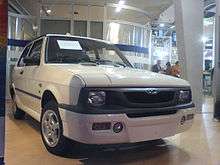
As the events of the wars of Yugoslav succession (1991–95 and 1999) unfolded, Zastava (GB) LTD became a barely noticed casualty. During Easter 1999, the Zastava factory in Kragujevac was targeted by NATO forces during the Kosovo campaign, and whilst severely damaged, was not put out of action. Supplies of vehicles to the United Kingdom were, however, reduced to a trickle in 1991 and 1992 and with the imposition of United Nations sanctions on Slobodan Milosević's rump Yugoslavia (consisting of Serbia and Montenegro), the company folded in 1993. The remaining Yugos on dealer forecourts were sold at drastically reduced prices or written off altogether as economically unviable.
Marketing
The Yugo was vigorously marketed in the late 1980s as a car that would fit into everybody's life, providing basic economical and reliable transportation along the lines of the Volkswagen Beetle and the earlier Ford Model T. The car was promoted as a uniquely affordable new vehicle — providing an option for buyers who would otherwise have chosen a used vehicle — and as a reliable second car for wealthier buyers. The Yugo carried the tagline "Everybody Needs A Yugo Sometime."[23] This marketing appealed successfully to its target market of low-budget new car buyers, as well as wealthier people looking for an affordable second or third car.[24] A popular ad included the 39-90 campaign, a play on the $3,990 price of the car.
Criticism and response
Along with other Central and Eastern European vehicles marketed in the West during the 20th century — such as the Škoda — the Yugo was subjected to derision by critics who pointed to its use of old-generation Fiat technology and to alleged issues with build quality and reliability. The Yugo was voted as one of Car Talk's worst cars of the millennium.[25] Similarly, the Yugo GV was listed on TIME's "The 50 Worst Cars of All Time" list,[26] and the Yugo 45 ranked #1 on Complex Magazine's "The 50 Worst Cars of the '80s" list.[27] Various other critics have added the Yugo to their lists of the worst cars.[28][29]
Defenders of the vehicle have counter-argued that the Yugo's reputation suffered due to an issue that also appeared with initially inexpensive cars such as the Chevrolet Chevette, Rambler, Crosley, and others — dealers were finding that too many owners were considering inexpensive cars as "disposable", and were failing to perform basic maintenance such as oil changes.
One critical maintenance issue specific to the Yugo 55 and 65 (the 45 was a 903 cc pushrod engine, with a timing chain) was the need for regular replacement of the interference engine's timing belt — every 40,000 miles (64,000 km).[29] In a non-interference engine, timing belt failure does not cause further damage to the engine. However, in an interference engine, failure of the timing belt disrupts the synchronization between pistons and poppet valves, causing them to collide with one another (hence the name interference engine), thus potentially destroying the engine. Though this requirement was stressed in owners' manuals, it was frequently overlooked by owners. The factory also stressed the need for 89-octane fuels for the low-compression engines.
Some Yugo owners have reported that regular oil changes and appropriate maintenance allow the cars to remain dependable and trouble-free.[30]
In 1989, 31-year-old Leslie Ann Pluhar, driving a 1987 Yugo over the Mackinac Bridge in Michigan, died when her Yugo went over the bridge's 36-inch (910 mm) railing during 50 mph (80 km/h) winds. The incident was widely publicized, with the make of car prominently identified. Many retellings claim that the car was physically lifted and blown off the bridge.[31][32] However, a lawsuit by the family of the victim made no such claim, but proposed that the wind contributed to a loss of control that ended with the car's going off the bridge. Expert testimony disputed whether the winds were a major factor. Another proposed explanation is that a collision with a guardrail on the bridge's median "launched" the car onto the opposite guardrail.[33]
Owners of the Yugo and related models in the former Yugoslavia benefit from a ready supply of inexpensive spare parts due to general continuity in the car's design; local mechanics' ready familiarity with the Yugo also lowers the cost of ownership, since Yugos are so common and are even used as practice cars for apprentice mechanics. Also, the simplicity of the car's engine makes it easy to fix, and many Yugoslavian owners tended to fix the car themselves. All parts for the Yugo are readily available in the United States.[34]
A common U.S. joke regarding an inefficient vehicle is "Yugo Nowhere" ("You Go Nowhere"), referring to the failure of the car's sales in the United States.
A Zastava 101 (a sedan variant of the Yugo line) has been featured on the British motoring show Top Gear, where it was featured in a segment filmed in Albania, where the three presenters referred to it as a "Bentley Mulsanne" after Bentley decided not to allow Top Gear to use an actual Mulsanne against a Mercedes S-Class 65 and a Rolls Royce Ghost. While presenters Richard Hammond and James May drove the very new Mercedes and Rolls Royce, respectively, Clarkson was originally supposed to drive the very new Bentley- so he had to drive the Yugo. In addition to Clarkson calling the Yugo "the least refined car I've ever driven", it was lambasted constantly, at one point overheated and failed to start, thoroughly physically trashed, and then driven off a cliff and destroyed while May was driving it to simulate a mock death for May after a staged police chase through Albania. In one segment in that episode, they attempted to put an obese Albanian man playing dead (sticking with their theme of which car they thought would be best for the Albanian Mafia) into the boot (trunk) of their cars. Surprisingly, the Yugo was the only successful car at this challenge, although the "dead" man was very visible in the car. It was also featured in one of Clarkson's motoring programs in the 1990s called Jeremy Clarkson: Unleashed on Cars. He drove the Yugo, and after lambasting its performance, styling, and build quality, he then blew it up with a tank gun, and ran it over and crushed it with that same tank, totally destroying the car and reducing it to scrap metal.[35]
End of production
With the 794,428th and final car, production ended on November 11, 2008.[36] Of that number, around 250,000 were exported to various countries.
Today
Years after its demise, the Yugo is still a common sight in Serbia, with almost 60,000 vehicles still in use, most of which were built in the 2000s. Parts are still readily available at most auto-parts stores and in scrapyards across the country. However, Yugos are rare in other Yugoslav republics (Excluding North Macedonia and Montenegro), particularly in Slovenia, because most of them were "imported" back to Serbia in the early 2000s, most likely because most of them were in good shape for their age.
In the United States, few Yugos are left in service, likely because of international sanctions imposed on Yugoslavia in the early 1990s, which limited the supply of spare parts and service locations. The United Kingdom has around 100 Yugos still in existence and an owners club has been created. Unlike in the United States, the Yugo was never considered to be one of the worst cars ever imported in the UK, partly because other much worse cars were imported from Eastern Europe, particularly from former Soviet states, and partly because the expectations were not so high as in the United States.
One interesting version of the Yugo, the automatic one, is increasingly rare and estimates say that around 20 are left in use in Serbia, and most of those were sold in 1992, just after the sanctions were imposed, fetching a large value on auctions. A small number of newer Yugos can be found with automatic transmissions, and they were mostly built by request and featured a 1.3 liter engine.
Early 1980-1985 models featured butterfly opening windows, round side indicators, only a single set of tail lights on each side of the car, no rear defroster, and usually a black interior with a black dashboard, and many metal trim pieces such as window crank handles and door handles. Since around 1985, the cars received more comfortable seating, a blue or brown dashboard, two-part tail lights on each side, square side signals, rear defroster, redesigned instrument cluster, and butterfly windows that did not open. In 1990, a fuel filler flap was added instead of a twist cap, and some minor interior and instrument cluster changes were implemented. In 1991, the dashboard was redesigned first for the Yugo GVX and then for the European model, side butterfly windows were removed, and a bigger tank was introduced. In 2000, the car received a new front fascia with new bumpers, rear spoiler, a redesigned dashboard, and seats. The latest changes were in 2007, with the introduction of a new instrument cluster.
One popular "upgrade" to older (and even new) Yugos is autogas (LPG) conversion which has gained widespread popularity in Serbia. Because most Yugos do not feature fuel injection, converting them to LPG is cheap and easy, and is paid off very quickly. One drawback of such conversions is that an already small trunk becomes almost useless, since an LPG tank takes up space. Such converted cars achieve better reliability since use of an unreliable gasoline pump is avoided. However, some cars have starting problems in very cold weather, because of improper LPG installation.
In popular culture
The car has achieved a symbolic status in former Yugoslavian countries due to the simplicity, reliability, and overall cheap price, and the Yugoslavian mentality of people regularly fixing their own cars instead of servicing them at their local garage. It was featured in many Yugoslavian films and TV series, and also in modern-day shows in former Yugoslavian countries. They are still very popular and are a common sight in former Yugoslavian countries (except Bosnia and Herzegovina and Slovenia), and the large number of parts make it easily repairable.
In stark contrast, in the United States, the car was frequently subjected to ridicule and mockery and it has a universally negative rating. Car Talk has rated it the "worst car of the millennium", and many car magazines and TV shows rate it as the worst car of the 1980s and also the worst car to be ever made. Despite the very low price setting in the US (with Yugo being the cheapest new car ever sold in the US when adjusted for inflation), it was ridiculed for the overall ugly design, poor quality, and large number of technical issues. Many American Yugos had faulty designs that were stressed in owners' manuals to be regularly serviced, but this caused even more ridicule due to owners overlooking these issues. The car has become a sort of a symbol for a lemon car. The car was also featured in many TV shows and films, satirizing the car's poor design (the most famous examples being a rusty, beige-colored Yugo GV featured in Die Hard with a Vengeance, and a taxi-yellow Yugo in Nick & Norah's Infinite Playlist).
A Yugo was prominently featured in the 1987 feature film Dragnet, with actor Dan Aykroyd even mentioning the car by make and model year in a voice-over.
In the 2000 movie Drowning Mona, everyone in the town of Verplanck, New York drives Yugos because in the fictional story of the film, Zastava (which in the film is falsely called the Yugo car company) chose the town for testing the car before its official launch on the US market.
In the animation film Cars 2, there is a loser gang that largely consists of Yugos (called "Hugos" in the film) as well as AMC Gremlins and AMC Pacers.
In an episode of Top Gear, Jeremy Clarkson drives a Yugo and calls it "a hateful, hateful car" and its performance so bad "you get overtaken by wildlife". In the end, he destroys it by shooting at it with a tank.[37]
In a later episode of Top Gear, on a visit to Albania, Jeremy Clarkson drives a red Yugo as a replacement for a Bentley Mulsanne, as an apparent dig at Bentley for not lending them a Mulsanne for that particular shoot. It was used as a joke car in comparison to Richard Hammond's Mercedes S-Class and James May's Rolls Royce Ghost. After a police chase after a supposed bank robbery, James May decides to drive the Yugo off a cliff, rather than fall into police custody.[38]
A Yugo is also prominently featured in the music video for the 2008 song The Day That Never Comes by Metallica.
In the 1999 film Bowfinger a poster in movie producer Bobby Bowfinger's office advertises his fictional film The Yugo Story.
In the 2011 film Good Luck Charlie, It's Christmas!, Teddy and Amy Duncan rent a Yugo for $50. Amy describes the car as "10 years older than [Teddy]," and "made in a country that no longer exists."
In the 2018 animated film Spider-Man: Into The Spider-Verse, a fictional modern version of the Yugo is advertised in Times Square.[39]
A Yugo was used and appears in Mura Masa's song Deal Wiv It.
See also
- Zastava Florida (also known as Yugo Sana)
- Zastava Skala (also known as Zastava 101)
- Zastava 10
- Zastava 750
References
Notes
- "Pre 36 godina sastavljen je prvi serijski Jugo" [The first Yugo was built 36 years ago] (in Serbian). Auto Magazin. 29 November 2016. Archived from the original on 2019-01-19.
- Vuic, Jason (2018-06-06). "A Quick Look at the Yugo, the Worst Car in History". Retrieved 2020-04-13.
- Homola, Peter (1985-02-07). "Zastava en cie" [Zastava and company]. De AutoGids (in Dutch). Vol. 6 no. 140. Brussels, Belgium: Uitgeverij Auto-Magazine. p. 54.
- Motronic MP3.1
- Cohen, Roger. "THE WORLD; A Defunct Car, Like Its Homeland, Was the Sum of Its Parts". Archived from the original on 2017-09-14. Retrieved 2017-02-28.
- Vuic, Jason (2010), The Yugo: The Rise and Fall of the Worst Car in History, New York City: Hill and Wang, p. 176, ISBN 978-0-8090-9891-0
- (in Chinese) english.eastday.com Archived 2006-02-12 at the Wayback Machine
- Vuic, p. 21
- Vuic, p. 11
- Vuic, p. 16
- Vuic, p. 83
- Vuic, p. 191
- Toledo Blade (April 21, 1992). "Poor sales, civil war end for boxy, undependable Yugo". Google News. The Toledo Blade Company. p. 8. Retrieved April 5, 2016.
- "Yugo Redux". Forbes.com. 2002-12-05. Archived from the original on 2002-12-05.CS1 maint: unfit url (link)
- "- The Detroit News - detroitnews.com". 2 January 2013. Archived from the original on 2 January 2013.
- Donna Harris (December 11, 2006). "Dealers stick with Bricklin on venture". Automotive News. Crain Communications. Retrieved April 12, 2016.
- Vuic, p. 111
- Vuic, p. 159
- The Pittsburgh Press (January 31, 1989). "Sagging sales drive Yugo America into bankruptcy". Google News. E. W. Scripps Company. p. 18. Retrieved April 8, 2016.
- "Yugo Economy Cars Fast Running Out of Gas on U.S. Market". Los Angeles Times. Reuters. September 5, 1990. Archived from the original on 2016-04-23. Retrieved April 8, 2016.
- Vuic, p. 194
- Vuic, p. 68
- Yugo on YouTube
- Peters, E. (2004). Automotive Atrocities: The Cars We Love to Hate. Motorbooks International.
- "What's the Worst Car of the Millennium?". Car Talk. 2011-06-07.
- Dan Neil and TIME. "The 50 Worst Cars of All Time". TIME. Archived from the original on 2016-04-14. Retrieved April 7, 2016.
- Stirling Matheson (February 4, 2013). "The 50 Worst Cars of the '80s". Complex Magazine. Complex Media. Archived from the original on 2016-03-31. Retrieved April 7, 2016.
- LA Times Staff. "The 10 worst cars sold in America". Los Angeles Times. Los Angeles Times Media Group. Archived from the original on 2016-04-07. Retrieved April 7, 2016.
- William Gock (May 16, 2011). "10 Cars That Deserved to Fail". Popular Mechanics. Hearst Corporation. Archived from the original on 2016-03-25. Retrieved April 7, 2016.
- "YUGO CARS.Web - English". Inet.hr. Archived from the original on 2011-06-14. Retrieved 2010-10-17.
- David Propson (2004-10-14). "How to Build a Better Bridge". New York Sun. Archived from the original on 2007-11-14. Retrieved 2007-10-26.
- "Mackinac Bridge Victim Is Recovered". Madison.com. 1989-10-02. Archived from the original on 2008-12-12. Retrieved 2008-10-27.
- Vuic, The Yugo.
- "Inside the Midwest-Bayless Fiat Shop - Feature". Car and Driver. Archived from the original on 2011-08-29. Retrieved 2011-09-29.
- Dušan Eremić (10 May 2008). "Jeremy Clarkson destroying Yugo 45 & Volvo". Archived from the original on 2015-09-25. Retrieved 2015-10-30 – via YouTube.
- Fawkes, Helen (2008-11-20). "Europe | Yugo production grinds to a halt". BBC News. Archived from the original on 2009-02-01. Retrieved 2009-07-10.
- Top Gear - Zastava Yugo 45 - Jeremy Blows Up Car :(, retrieved 2019-08-01
- Top Gear - Albanian Police Chase - James Drives Yugo Off Cliff :(, retrieved 2019-10-14
- Torchinsky, Jason. "The Most Important Thing About The New Spider-Man Trailer Is That There's A New Yugo". Jalopnik. Retrieved 21 November 2019.
Sources
- Georgano, G.N. (1985): The complete encyclopaedia of motorcars: 1885 to present. George Rainbird Publishing. ISBN 0-11-702319-1.
- Vuic, Jason: The Yugo: The Rise and Fall of the Worst Car in History, Hill and Wang 2010, ISBN 0-8090-9891-1
- Automobil Revue - Revue Automobile Yearbooks
- SynLube: YUGO 45 History
